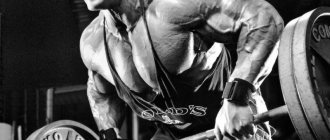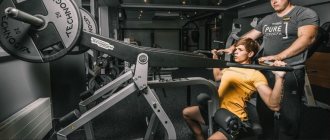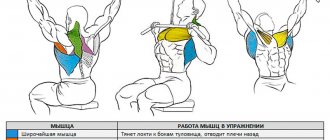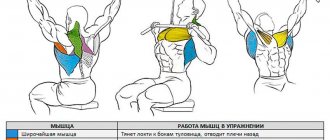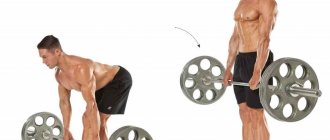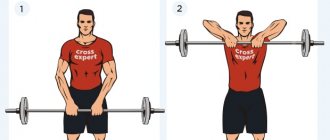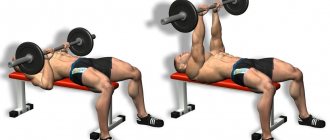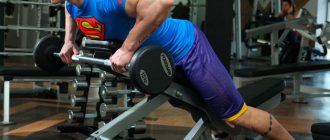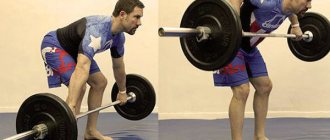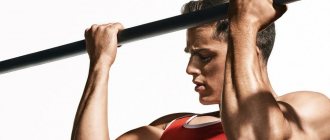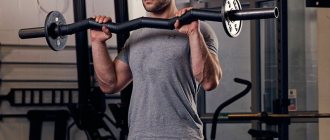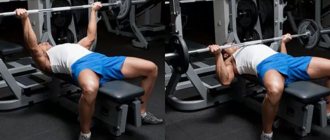The reverse-grip bent-over barbell row is a basic strength exercise that involves the shoulder and elbow joints. Most of the load falls on the lower latissimus muscles, that is, the muscles of the back. If you compare the bent over row with the classic one, that is, straight row, the biceps are involved much more actively.
Execution technique
To get the most out of the reverse grip barbell row, you need to follow the correct sequence for each action.
Initial position
Getting into the correct position involves taking the following steps:
- the barbell is removed from the racks or the projectile is lifted from the floor surface using the deadlift technique;
- a reverse grip suggests that the palms should be directed upward, and the location of the shoulder girdle should be wider than their location;
- lower your arms down, completely straightening your elbow joints, tilt your body slightly forward, and keep your back straight, while your knees are bent.
This position must be taken every time you perform bent-over rows with a reverse grip.
Performance
When the correct position is assumed, begin the exercise itself:
- Without any sudden jerks or body swaying, while exhaling, the sports equipment is pulled along the hips to the waist. Concentrate as much as possible on contracting the latissimus dorsi muscles and bringing the shoulder blades together.
- At the moment of peak contraction, which occurs at the highest point, they are delayed for a couple of seconds.
- Inhale and smoothly lower the barbell to the bottom position. The stabilizer muscles, that is, the flexors of the shoulder joint, are involved in the work.
Without rest, they immediately begin to perform the next approach, that is, no rest.
TECHNIQUE: Bent-over barbell row with reverse grip [Avtaev LIFE]
Number of repetitions
The specific number depends on the level of training:
- a beginner should do 3 sets of 8 times;
- for an experienced amateur - 4 sets of 10 times;
- athlete - 4 sets of 12 times.
You can’t immediately chase the maximum. The load should be increased gradually.
Note!
- Cheating should not be allowed, nor should lifting the sports equipment with a jerk. Otherwise, the target muscles will not be fully worked.
- Do not straighten the body at the highest point. Why? Because this transfers the load to the extensors, and this can cause injury.
- Don't round your back. Such an action is completely unsafe for the lumbar region.
- Do not perform deadlifts with biceps alone. The biceps muscles are in any case involved when performing the movement. The latissimus dorsi, but not the biceps, require maximum tension.
Understanding these points allows you to get the most out of a basic strength exercise.
Main mistakes:
- Shoes. Do not wear shoes with soft or springy soles, such as sneakers. Heavy weights will push them into the floor. Barbells with firm heels are best.
- Incorrect foot placement. Legs that are too wide apart will not give any positive effects, but on the contrary, will interfere with the arms when lifting the barbell.
- Back. Don't lift weights with your back. The initial phase begins solely with a powerful thrust of the hips.
- Bar movement. Take care that the barbell does not roll on the floor. When you lower it during the approach, it should not slide or roll away. In this regard, doing deadlifts in a frame or machine is much more convenient.
- Spades. Toes should be on the same line, no leg should protrude beyond this line. Or not reach it. Asymmetry is unacceptable!
- Too much weight. The technique needs to be honed on light weights.
- Gloves. It is best to grip the bar without gloves, so your grip will be stronger. If you want to firmly fix your hands, sprinkle the barbell with talcum powder or magnesium.
- Injuries. To avoid chafing your knees, use bandages. Or do deadlifts in your pants. The wounds take a long time to heal and interfere with training.
- Knee bending. When lowering the bar, many athletes bend their knees too early. You only need to bend them when the bar itself reaches them.
- Hull deflection. It is impossible to strongly tilt the body back at the top point of the amplitude.
The optimal training regimen for an athlete is 1 deadlift per week. You can do 2 deadlifts if one of them is with dumbbells, for example, on straight legs, and the second is classic. If you work with heavy weights, it is better to leave the frequency at 1 time per week. The load on the lower back is very large, both joints and ligaments are loaded. They need time to recover.
Deadlift video:
0
General recommendations
- The position of the body must be fixed at the very beginning of the exercise and not change it until the end of the entire approach. This allows you to avoid overloading the lower back and direct all the load to the latissimus muscles.
- Try to keep your spine in a neutral position. To avoid losing control of your posture, you should not lower your head down.
- You must strive to move your elbows back as far as possible and touch the barbell with your body. This allows the muscles to contract as much as possible.
Working muscles
The exercise is aimed at growing the back in width and thickness. Main working muscles: - Latissimus. - Large round muscles of the back.
We focus on these muscles during training.
In the upper phase of the movement, the following are included in the work as much as possible:
- Trapezoidal. - Diamond-shaped.
We focus on them at the top point of the movement.
Auxiliary:
- Deltoid. - Biceps. - Forearm.
You should try to neutralize the load on them using the right technique.
Analysis of the exercise
What muscles work
Bent-over barbell rows with a reverse grip affect:
- The main muscles involved are the latissimus dorsi in the lower region, biceps brachii, middle trapezius, posterior deltoids, infraspinatus.
- The auxiliary muscles include the muscles of the forearms, the teres major and minor, the rhomboids, and the pectoralis major muscles.
Advantages and disadvantages
The main advantages of the barbell row with a reverse grip:
- wider amplitude of traction movement compared to the classic version;
- development of grip strength;
- similar to other variants of horizontal traction, this exercise helps to increase the thickness of the back muscles;
- posture improves, so this basic strength exercise is included in the training program for those who suffer from thoracic kyphosis;
- Performing bent-over barbell rows with a reverse wide grip makes it possible to work with large weights, unlike the classic version.
The exercise is not without its downsides. The main thing is that the supunion row has a rather difficult execution technique for beginners to master, so it is best to first work out the execution technique with dumbbells.
Preparation for execution
To do a bent-over barbell row with reverse coverage, you first do a warm-up complex, supplemented by a five-minute aerobic exercise. The depth of the tilt is achieved by pre-stretching the ankle and hamstrings.
Attention! It is not recommended to overload the rectus dorsi muscles, since most of the load during the exercise falls on them.
Proper execution
To get the maximum benefit from the exercise, you should consider several important nuances:
- It is necessary to do barbell rows with a supinated grip solely through the efforts of the latissimus muscles, when the biceps, deltoids and trapezius are involved to a minimum. You should avoid body rocking and sudden jerks while lifting the barbell.
- The projectile is lifted either as in a classic deadlift, or from the racks of a power frame. The second option allows you to save energy, which allows you to do one additional approach.
- The return of the projectile to the lowest point is controlled by activating the flexors.
- There is no need to tilt the body much downwards. The angle of the body position relative to the vertical position ranges from 40 to 45 degrees.
- Slightly bent knees allow you to achieve stability in your body position and reduce the likelihood of injury to the lumbar region.
- Working weights should be selected taking into account the athlete’s technique and training. If they are excessively large, the exercise will not bring the desired effect.
- The sports equipment is lifted with a fully straightened arm to the upper end point, which is located approximately in the center of the abdomen.
- The forearms move strictly along the body. The elbows should be directed vertically upward when performing the movement.
If you follow these recommendations, the likelihood of injury is eliminated and the effectiveness of the exercise itself increases.
Bent over barbell row with reverse grip
Errors
When performing bent-over barbell rows with a reverse grip, you must not:
- change the position of the body and strongly tilt the upper body when moving;
- “pull out” the bar from the lowest point;
- uncontrollably reset the barbell to its original position;
- round your back;
- use your biceps to the maximum;
- wring your hands.
Particular attention should always be paid to weight selection.
Efficiency Tips
- The main active muscles when rowing a barbell are the latissimus. Changing the grip width allows you to control the load on the auxiliary muscles. The load on the shoulder extensors increases in proportion to the decrease in grip width. The wider it is, the higher the load on the muscles responsible for horizontal abduction of the shoulders and adduction of the shoulder blades to the spine, that is, the infraspinatus, trapezius, minor and major round, diamond-shaped.
- At the lowest point, straighten the elbow joints. This allows you to minimize the load on the biceps. The biceps muscles that are “connected” in the pre-start position are already difficult to relax during the pulling movement.
- Flexing the knee joints when performing deadlifts allows you to achieve the deepest possible bend without putting excessive strain on the lower back.
- Straps allow you to strengthen your grip, but they are not recommended for beginners. Grip strength should increase naturally as the working weight increases.
The Importance of Stretching
Unfortunately, this is not a bench press where poor stretching will not ruin the technique. We'll need a good stretch. The fact is that the starting position for the exercise requires good flexibility of the lower back and back. This pull is associated with lumbar flexion. Therefore, you will need to stretch it as much as possible.
Poor stretching will prevent you from getting into the desired position, which will prevent you from doing the exercise correctly. Correct execution means smoothness, flexibility and control over every movement. Remember this.
Inclusion in the program
The exercise is a heavy basic one, so it must be included in the training program for the development of back muscles. The working weight should be selected so that you can perform at least 10-12 repetitions in 3-4 approaches. Work in power mode should take place in a low repetition range, that is, from 3 to 5 times per approach.
The exercise is perfect for inclusion in a split program, which involves joint training of both the biceps and back muscles. The combination of supinated and classic rows allows you to make your workouts more varied and use all the back muscles. With a direct grip, the upper lats are involved, and with a reverse grip, the lower lats are involved.
Advantages and disadvantages
Advantages:
- Provides an increase in the volume of the latissimus and trapezius muscles.
- It is an effective basic exercise that gives a powerful anabolic boost to the development of all muscles of the body.
- Develops flexibility of the hip joints and elasticity of the hamstrings.
- Strengthens deep stabilizer muscles that support the spine in the correct position and corrects posture.
Flaws:
- With a reverse grip, a large load falls on the biceps brachii muscles. That is, when gripping from below, the synergistic muscles will turn on more strongly and remove some of the load from the back.
- It has a high risk of injury, since when working with heavy weight, especially with incorrect technique, there is a high risk of injuring the spine.
- Not suitable for beginners, since untrained core muscles will not cope with the load on the back in a horizontal position.
Harm of barbells to human anatomy
Well-built mammals that walk on four legs and do not put too much stress on their spine, pelvis and veins of the hind legs are looked at with bewilderment by powerlifters, bodybuilders, weightlifters and crossfitters.
They think: “Lord! These people have problems at work, in the family, with veins and the spine, and they still push under a barbell with a weight several times their own and spend a lot of time going to chiropractors to treat back pain. For what?!"
Sometimes I think the evolution of the human brain is over exaggerated. Although the evolution of many athletes' legs is truly impressive.
In young years, intervertebral discs forgive abuse of a barbell against an imperfect human body, but the closer old age is, the greater the wear of these discs and the more often back pain occurs.
Let me remind you that the human body is designed by nature to last 40 years. For skeptics, a simple fact: only the invention of vaccines in the twentieth century increased the average life expectancy of humanity on Earth by 20-25 years.
Why do deadlifts?
Everyone does deadlifts: powerlifters and weightlifters, bodybuilders and fitness athletes, runners, football players and many other athletes, as well as older people and those who want to quickly recover from an injury.
You should do this exercise, and there are five reasons why.
Deadlifts work many muscle groups
During execution, the muscles of the thighs and legs, buttocks, and back extensors are loaded. The movement also involves the rectus abdominis, obliques, latissimus, trapezius, rhomboids, scapular stabilizers, and forearm muscles.
It increases performance in various sports
Performing deadlifts teaches the brain to coordinate muscle action, recruit more muscle fibers, and do it exactly when needed. As a result, the body becomes stronger and moves more efficiently, which has a positive effect on other activities.
Exercise protects against injuries in everyday life
The motor pattern of the deadlift occurs in everyday life when you lift something heavy from the floor. By learning safe movement techniques, you won't hurt your back lifting the edge of a couch or dragging a bag of cement. In addition, deadlifts promote Changes in bone mineral density in response to 24 weeks of resistance training in college‑age men and women. increasing bone mineral density, which helps reduce the risk of fractures.
Suitable for any skill level
The movement itself is quite simple and does not require special flexibility, speed or strength. Any limitations of a person can be overcome by using modifications of the exercise.
The deadlift has many variations
The exercise can be done with a barbell, dumbbells and kettlebells, with different leg positions, grip widths and knee bend angles. Each variation has its own advantages, and you can use this to work on your weak points.
Currently reading
